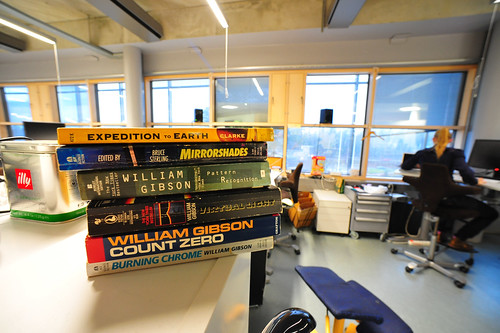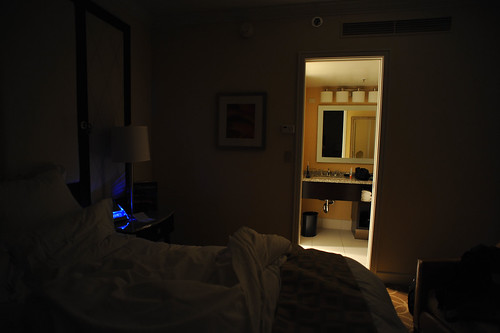

Spied about while meeting-and-greeting Helsinki colleagues at Nokia House, some materials that I couldn’t help but recognize in the context of the early morning writing I’ve been trying to do, refining the last three presentations I’ve given last month on “Design Fiction.”
There’s a curious practice here that I don’t think is entirely new, but there are some exciting directions from whence the idea has circulated, drawing me back to the relationship between the science of fact and the science of fiction, and then to the old science-technology-studies principles, and Latour, who taught me to not have anything to do with clearly delineated boundaries between much of anything, particularly any kind of science. This is where it starts.
I can imagine a practice that can comfortably work in between and even be comfortable swapping properties between fact and fiction for the purposes of telling a story that is a materialization of an idea, or one’s imagination. It’s like science fiction made real, without the weight and burden of the whole truth.
Why science fiction? Because it’s a literary genre that can comfortably stretch the now out toward a possible near future world better than other ways of story telling. (I’m perfectly happy to accept that there are others — the symmetry though between the hubris of science fact and the imaginative whimsy of science fiction is too hard to resist.) That practice is some derivation of design probably.
Why design? Because so far it seems to be less inclined to be as disciplined as the other practices I’ve tried, it has a vocabulary that includes the word “people”, it can work with vernacular, everyday, even mundane practices quite well, it implies working with one’s hands and head and even risking a nicked finger, etc.
While a restless graduate student at the University of Washington I worked at a place called the Human Interface Technology Lab, or HITLab. The lab was working quite hard on virtual reality (VR), another (again) of a kind of immersive, 3D environment that, today, one might experience as something like Second Life. The technology had a basic instrumental archetype canonized in a pair of $250,000 machines (one for each eyeball) called, appropriately, the RealityEngine. With video head mount that looked like a scuba-mask, one could experience a kind of digital virtual world environment that was exciting for what it suggested for the future, but very rough and sparse in its execution. As I was new to the new HITLab (still in temporary trailers on a muddly slope by the campus’ steam plant), I went through the informal socialization rituals of acquainting myself to the other members of the team — and to the idioms by which the lab shared its collective imaginary about what exactly was going on here, and what was VR. Anything that touches the word “reality” needs some pretty fleet-footed references to help describe what’s going on, and a good set of anchor points so one can do the indexical language trick of “it’s like that thing in..” For the HITLab, the closest we got to a shared technical manual was William Gibson’s
“Neuromancer” which I was encouraged to read closely before I got too far involved and risked the chance of being left out of the conversations that equated what we were making with Gibson’s “Cyberspace Deck”, amongst other science fiction props. I mean — that’s what we said. There was no irony. It was the reference point. I’m serious. I mean..this is from a paper that Randy Walser from Autodesk wrote at the time:
which I was encouraged to read closely before I got too far involved and risked the chance of being left out of the conversations that equated what we were making with Gibson’s “Cyberspace Deck”, amongst other science fiction props. I mean — that’s what we said. There was no irony. It was the reference point. I’m serious. I mean..this is from a paper that Randy Walser from Autodesk wrote at the time:
In William Gibson’s stories starting with Neuromancer, people use an instrument called a “deck” to “jack” into cyberspace. The instrument that Gibson describes is small enough to fit in a drawer, and directly stimulates the human nervous system. While Gibson’s vision is beyond the reach of today’s technology, it is nonetheless possible, today, to achieve many of the effects to which Gibson alludes. A number of companies and organizations are actively developing the essential elements of a cyberspace deck (though not everyone has adopted the term “deck”). These groups include NASA, University of North Carolina, University of Washington, Artificial Reality Corp., VPL Research, and Autodesk, along with numerous others who are starting new R&D programs.
(PDF: http://tr.im/zoj)
There’s nothing wrong with this — it’s all good stuff. It’s a way of creating that shared imaginary that knits the social formations together. Latour would remind us that this is the socialization practices — this is an instance of the “how” and the “why” of technology. Technology is precisely the socialization of ideas.
It’s refreshing when you come across some good fiction — science or otherwise — positioned to be read, referred back to or just as a kind of badge to mark the contours of that shape and influence. Nothing literal — just literary, the edges of design fiction practices.
Continue reading Design Fiction / Science Fiction












